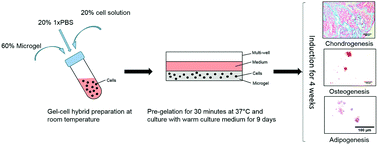当前位置:
X-MOL 学术
›
J. Mater. Chem. B
›
论文详情
Our official English website, www.x-mol.net, welcomes your feedback! (Note: you will need to create a separate account there.)
Enhanced multi-lineage differentiation of human mesenchymal stem/stromal cells within poly(N-isopropylacrylamide-acrylic acid) microgel-formed three-dimensional constructs†
Journal of Materials Chemistry B ( IF 7 ) Pub Date : 2018-03-02 00:00:00 , DOI: 10.1039/c8tb00376a Jiabin Zhang 1, 2, 3, 4 , Seonho Yun 1, 2, 3, 4 , Jingxiu Bi 1, 2, 3, 4 , Sheng Dai 1, 2, 3, 4 , Yuguang Du 5, 6, 7, 8 , Andrew C. W. Zannettino 2, 3, 4, 9 , Hu Zhang 1, 2, 3, 4
Journal of Materials Chemistry B ( IF 7 ) Pub Date : 2018-03-02 00:00:00 , DOI: 10.1039/c8tb00376a Jiabin Zhang 1, 2, 3, 4 , Seonho Yun 1, 2, 3, 4 , Jingxiu Bi 1, 2, 3, 4 , Sheng Dai 1, 2, 3, 4 , Yuguang Du 5, 6, 7, 8 , Andrew C. W. Zannettino 2, 3, 4, 9 , Hu Zhang 1, 2, 3, 4
Affiliation

|
Human mesenchymal stem/stromal cells (hMSCs) are a potential cell source of stem cell therapy for many serious diseases and hMSC spheroids have emerged to replace single cell suspensions for cell therapy. Three-dimensional (3D) scaffolds or hydrogels which can mimic properties of the extracellular matrix (ECM) have been widely explored for their application in tissue regeneration. However, there are considerably less studies on inducing differentiation of hMSC spheroids using 3D scaffolds or hydrogels. This study is the first to explore multi-lineage differentiation of a stem cell line and primary stem cells within poly(N-isopropylacrylamide) (p(NIPAAm))-based thermosensitive microgel-formed constructs. We first demonstrated that poly(N-isopropylacrylamide-co-acrylic acid) (p(NIPAAm-AA)) was not toxic to hMSCs and the microgel-formed constructs facilitated formation of uniform stem cell spheroids. Due to functional enhancement of cell spheroids, hMSCs within the 3D microgel-formed constructs were induced for multi-lineage differentiation as evidenced by significant up-regulation of messenger RNA (mRNA) expression of chondrogenic and osteogenic genes even in the absence of induction media on day 9. When induction media were in situ supplied on day 9, mRNA expression of chondrogenic, osteogenic and adipogenic genes within the microgel-formed constructs were significantly higher than that in the pellet and 2D cultures, respectively, on day 37. In addition, histological and immunofluorescent images also confirmed successful multi-lineage differentiation of hMSCs within the 3D microgel-formed constructs. Hence, the thermosensitive p(NIPAAm-AA) microgel can be potentially used in an in vitro model for cell differentiation or in vivo transplantation of pre-differentiated human mesenchymal stromal cells into patients for specific lineage differentiation.
中文翻译:

人间充质干聚内/基质细胞的增强的多谱系分化(Ñ -isopropylacrylamide -丙烯酸)微凝胶形成的三维结构†
人间充质干细胞/基质细胞(hMSCs)是用于许多严重疾病的干细胞疗法的潜在细胞来源,并且hMSC球体已经取代了用于细胞疗法的单细胞悬液。可以模拟细胞外基质(ECM)特性的三维(3D)支架或水凝胶已广泛用于组织再生中。但是,使用3D支架或水凝胶诱导hMSC球体分化的研究很少。这项研究是首次探索基于聚(N-异丙基丙烯酰胺)(p(NIPAAm))的热敏性微凝胶形成的构建体中干细胞系和原代干细胞的多系分化。我们首先证明了聚(ñ -isopropylacrylamide-合作-丙烯酸)(p(NIPAAm-AA))对hMSC无毒,微凝胶形成的构建体促进均匀干细胞球体的形成。由于细胞球体的功能增强,即使在没有诱导培养基的情况下,软骨和成骨基因的信使RNA(mRNA)表达的显着上调也证明了3D微凝胶形成的构建物中的hMSC可以进行多谱系分化。第9天。当诱导培养基就位时从第9天开始,第37天,形成微凝胶的构建体中的成软骨,成骨和成脂基因的mRNA表达分别显着高于沉淀和2D培养物中的mRNA。此外,组织学和免疫荧光图像也证实了成功的多hMSC在3D微凝胶形成的构建体中的谱系分化。因此,热敏性p(NIPAAm-AA)微凝胶可潜在地用于体外模型中进行细胞分化,或将预分化的人间充质基质细胞体内移植到患者中进行特定谱系分化。
更新日期:2018-03-02
中文翻译:

人间充质干聚内/基质细胞的增强的多谱系分化(Ñ -isopropylacrylamide -丙烯酸)微凝胶形成的三维结构†
人间充质干细胞/基质细胞(hMSCs)是用于许多严重疾病的干细胞疗法的潜在细胞来源,并且hMSC球体已经取代了用于细胞疗法的单细胞悬液。可以模拟细胞外基质(ECM)特性的三维(3D)支架或水凝胶已广泛用于组织再生中。但是,使用3D支架或水凝胶诱导hMSC球体分化的研究很少。这项研究是首次探索基于聚(N-异丙基丙烯酰胺)(p(NIPAAm))的热敏性微凝胶形成的构建体中干细胞系和原代干细胞的多系分化。我们首先证明了聚(ñ -isopropylacrylamide-合作-丙烯酸)(p(NIPAAm-AA))对hMSC无毒,微凝胶形成的构建体促进均匀干细胞球体的形成。由于细胞球体的功能增强,即使在没有诱导培养基的情况下,软骨和成骨基因的信使RNA(mRNA)表达的显着上调也证明了3D微凝胶形成的构建物中的hMSC可以进行多谱系分化。第9天。当诱导培养基就位时从第9天开始,第37天,形成微凝胶的构建体中的成软骨,成骨和成脂基因的mRNA表达分别显着高于沉淀和2D培养物中的mRNA。此外,组织学和免疫荧光图像也证实了成功的多hMSC在3D微凝胶形成的构建体中的谱系分化。因此,热敏性p(NIPAAm-AA)微凝胶可潜在地用于体外模型中进行细胞分化,或将预分化的人间充质基质细胞体内移植到患者中进行特定谱系分化。


























 京公网安备 11010802027423号
京公网安备 11010802027423号